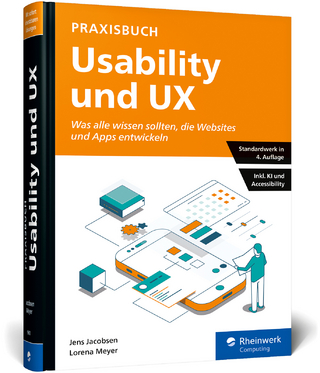
Worth-Focused Design, Book 2
Approaches, Context, and Case Studies
Seiten
2020
Morgan & Claypool Publishers (Verlag)
9781681738154 (ISBN)
Morgan & Claypool Publishers (Verlag)
9781681738154 (ISBN)
- Keine Verlagsinformationen verfügbar
- Artikel merken
Introduces the concept of worth for design teams, relates it to experiences and outcomes, and describes how to focus on worth when researching and expressing design opportunities for generous worth.
This book introduces the concept of worth for design teams, relates it to experiences and outcomes, and describes how to focus on worth when researching and expressing design opportunities for generous worth. Truly interdisciplinary teams also need an appropriate common language, which was developed in the companion book Worth-Focused Design, Book 1: Balance, Integration, and Generosity (Cockton, 2020a). Its new lexicon for design progressions enables a framework for design and evaluation that works well with a worth focus.
Design now has different meanings based upon the approach of different disciplinary practices. For some, it is the creation of value. For others, it is the conception and creation of artefacts. For still others, it is fitting things to people (beneficiaries). While each of these design foci has merits, there are risks in not having an appropriate balance across professions that claim the centre of design for their discipline and marginalise others. Generosity is key to the best creative design delivering unexpected worth beyond documented needs, wants, or pain points. Truly interdisciplinary design must also balance and integrate approaches across several communities of practice, which is made easier by common ground. Worth provides a productive focus for this common ground and is symbiotic with balanced, integrated, and generous (BIG) practices. Practices associated with balance and integration for worth-focused generosity are illustrated in several case studies that have used approaches in this book, complementing them with additional practices.
This book introduces the concept of worth for design teams, relates it to experiences and outcomes, and describes how to focus on worth when researching and expressing design opportunities for generous worth. Truly interdisciplinary teams also need an appropriate common language, which was developed in the companion book Worth-Focused Design, Book 1: Balance, Integration, and Generosity (Cockton, 2020a). Its new lexicon for design progressions enables a framework for design and evaluation that works well with a worth focus.
Design now has different meanings based upon the approach of different disciplinary practices. For some, it is the creation of value. For others, it is the conception and creation of artefacts. For still others, it is fitting things to people (beneficiaries). While each of these design foci has merits, there are risks in not having an appropriate balance across professions that claim the centre of design for their discipline and marginalise others. Generosity is key to the best creative design delivering unexpected worth beyond documented needs, wants, or pain points. Truly interdisciplinary design must also balance and integrate approaches across several communities of practice, which is made easier by common ground. Worth provides a productive focus for this common ground and is symbiotic with balanced, integrated, and generous (BIG) practices. Practices associated with balance and integration for worth-focused generosity are illustrated in several case studies that have used approaches in this book, complementing them with additional practices.
University of Sunderland
Preface
Acknowledgments
Wo-Fo Success Needs Appropriate Design Progressions
Framing Design Purpose as Worth
Mixing Balance at All Scopes of Design
Integrating Across Design Arenas
Supported Case Studies: From Grounded to Worth-Centred Design
Unsupported and Taught Case Studies: Adding BIG to Wo-Fo
The Past, Present, and Future of BIG Wo-Fo
Glossary and Abbreviations
References
Author Biography
| Erscheinungsdatum | 10.05.2020 |
|---|---|
| Reihe/Serie | Synthesis Lectures on Human-Centered Informatics |
| Verlagsort | San Rafael |
| Sprache | englisch |
| Maße | 191 x 235 mm |
| Themenwelt | Mathematik / Informatik ► Informatik ► Grafik / Design |
| Informatik ► Software Entwicklung ► User Interfaces (HCI) | |
| ISBN-13 | 9781681738154 / 9781681738154 |
| Zustand | Neuware |
| Informationen gemäß Produktsicherheitsverordnung (GPSR) | |
| Haben Sie eine Frage zum Produkt? |
Mehr entdecken
aus dem Bereich
aus dem Bereich
Kindersachbuch über die Welt von Morgen
Buch | Hardcover (2025)
Gabriel in der Thienemann-Esslinger Verlag GmbH
CHF 24,90
Wissensverarbeitung - Neuronale Netze
Buch | Hardcover (2023)
Carl Hanser (Verlag)
CHF 48,95
was alle wissen sollten, die Websites und Apps entwickeln
Buch | Hardcover (2024)
Rheinwerk (Verlag)
CHF 55,85


